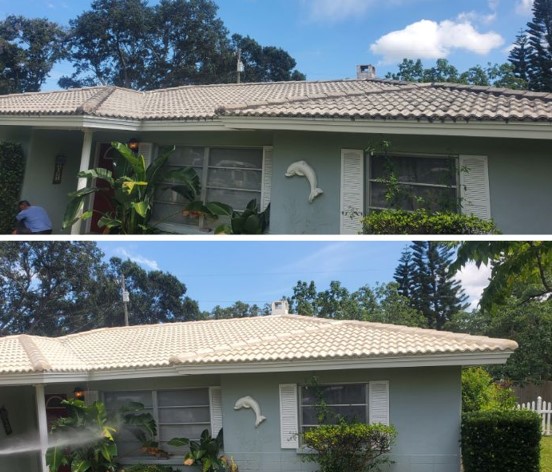Essential Roof Pressure Washing Tips for a Safe and Effective Clean

Maintaining a clean roof is important for the health of your home and its curb appeal. Over time, roofs can accumulate dirt, moss, algae, and other debris, which, if left unchecked, can cause damage. Roof pressure washing is an effective way to clean your roof and extend its lifespan, but it must be done carefully to avoid causing harm.
In this blog, we’ll discuss the essential tips for safe and effective roof pressure washing, helping you understand how to keep your roof in top shape while minimizing any risks.
Know Your Roof Material
The first step in roof pressure washing is knowing your roof material. Different materials require different approaches, and using the wrong method can cause significant damage.
For example, asphalt shingles are common on residential roofs but can be easily damaged if too much pressure is applied. On the other hand, metal roofs are much more durable and can handle higher pressure settings. Tile roofs may also require a gentler touch, as the tiles can crack or dislodge if not handled properly.
Before starting, it’s essential to determine whether roof pressure washing is the right cleaning method for your particular roof material. If you’re unsure, consulting with a professional is always a good idea. Knowing the right approach can make all the difference in maintaining the integrity of your roof while cleaning it.
Use the Right Pressure Setting
One of the most common mistakes homeowners make is using too much pressure. Roofs, especially those with asphalt shingles, are delicate, and excessive pressure can strip away protective granules, weakening the roof.
For safe roof pressure washing, it’s recommended to use a lower pressure setting, typically between 1,200 to 1,500 PSI. This is enough to clean off dirt, algae, and grime without risking damage to the shingles or other roofing materials. It’s also a good idea to start at the lowest pressure setting and gradually increase if needed, always testing a small, inconspicuous area first.
Using the correct pressure provides an effective clean and protects your roof from unnecessary wear and tear.
Angle the Nozzle Correctly
Another key factor in roof pressure washing is the angle of the nozzle. Spraying water at the wrong angle can force water under shingles or tiles, which can lead to leaks and water damage.
Always aim the nozzle downward and at a shallow angle to avoid this. This will direct the water in a way that cleans effectively without pushing it under the roofing material. It’s also important to keep the nozzle at least 12 inches away from the roof surface to avoid concentrating too much pressure in one spot.
Keeping the right distance and angle ensures that your roof gets a thorough cleaning while reducing the risk of water intrusion.
Use Cleaning Solutions Wisely
While water alone can clean a roof, adding cleaning solutions can improve the effectiveness of roof pressure washing, particularly when dealing with tough grime, algae, or moss. However, not all cleaning solutions are safe for roofs, so choosing the right one is important.
For roof pressure washing, opt for roof-safe cleaners that are specifically designed to break down moss, algae, and dirt without damaging your roofing material. Avoid using harsh chemicals like bleach, which can erode the materials over time and damage nearby plants.
A common approach is to apply the cleaning solution using a soft-wash method before rinsing it off with low-pressure water. This method ensures the grime is broken down without needing to use high pressure, which could harm the roof.
Prioritize Safety
Roof pressure washing can be dangerous, especially for those inexperienced in working on roofs. Wet roofs become slippery, and handling a pressure washer adds another layer of risk.
Always wear non-slip shoes and use safety harnesses when working on the roof to stay safe. It’s also important to have a partner present in case of an emergency and to avoid roof pressure washing when the roof is already wet or in windy conditions.
Hiring a professional is best if you’re uncomfortable with heights or unsure about operating a pressure washer on your roof. This reduces the risk of injury and makes sure that your roof will be cleaned properly and safely.
Conclusion
Roof pressure washing is an excellent way to remove dirt, moss, and algae, keeping your roof looking great and functioning well for years to come. However, it’s important to approach the task with care. Understanding your roof material, using the correct pressure settings, angling the nozzle properly, and selecting the right cleaning solutions are all essential to achieving a safe and effective clean.
By following these tips, homeowners can protect their roofs from damage while making sure they stay clean and free of harmful debris.
If you’re unsure about handling roof pressure washing on your own, Battle Creek Power Washing Pros is here to help! Our expert team provides safe and effective roof cleaning services to protect your home. Contact us today for a consultation and let us take care of your roof cleaning needs!





